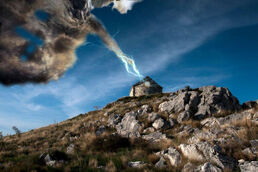Author's note: Story was copied from Slavorum
In the hinterlands of Split, Croatia, there is a very special mountain.

Rage of Thunder God
This mountain bears the name of the ancient god Perun, and it is because of him that St. George had so many troubles with a little church. The Hinterlands were always special, wild places. Old gods lingered there longer, and strange things lurked in the night, far away from the city lights and the city steel, and far from the new gods and saints the traders, priests and conquerors brought with them. And there is perhaps no place more wild and primal than Perun.
How many gods can claim an entire mountain in their own name, to claim it as their seat of power and their special place? Perun has over a dozen of them! For the old Slavic people, the mountain Perun was not only named so for the thunderstorms that gathered above it, but also because, they believed, it truly was a sacred place, as proven in part by its oak forest. And oak was, as we know, Perun's main symbol, this is why he has a statue placed on top of the mountain. Though we don’t see any evidence of it today, there are many rumors that this was also a place for ritual sacrifices and worship.
But times change, and new gods move into the place of the old, or, seem to try to. With the arrival of Christianity to these wild and magical places, the Church made one of their own saints into the image of the mighty Perun. This was St. George. The Christians did what every new religion did with the old one- they adopted and adapted the pantheon, and built new temples atop the old ones. Old gods donned new garbs and new names, and were still worshiped the same. You can see the attempts of it in the St. George chapel on top of Perun, where it was long assumed that one of the relief figures was st Michael or St. George defeating the great serpent, but the dedicated archaeologist Ante Milošević came to the conclusion that this was, in fact, a representation of Perun battling Veles.

The carving in question
This should, perhaps, be your first clue as to how Perun and his followers took to change. Even though a new temple was built, the craftsmen were all locals, all devout to their old ways, and carved the likeness of the one they prayed to for generations, Perun the Striker, the conqueror of Veles, and even though the new religion changed his name, it was, to them, still the same deity.
The second, and by far the more important clue, is the interesting meteorological phenomena recorded on that special spot. You would expect that a hilltop dedicated to Perun would get its fair share of thunderstorms and lightning strikes, but it seems that this new name and temple were an insult to Perun, even though his followers decided to carve his likeness into it, and he decided to do something about it.
And so the Mighty Perun unleashed his full force, and pelted the little church with lightning strikes and storms over decades and centuries. It was damaged numerous times, and repaired nearly as many as people tried to save this small temple atop an ancient mountain as their new place of worship. But nothing could truly match Perun’s might, and now the church is destroyed, nothing remains of it except for some ruins. St. George lost the battle against Perun and was exiled from the mountain.
There have been talks and discussions of rebuilding and repairing it, but those who do might risk Perun’s wrath, and he has shown himself to be a very opinionated deity. Perhaps he could be appeased by expanding his oak grove, and by carving some more statues of him. It is, after all, his mountain.